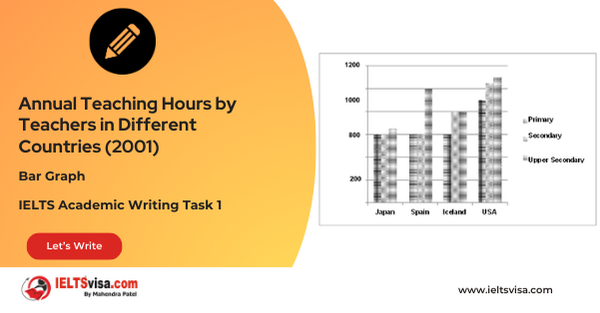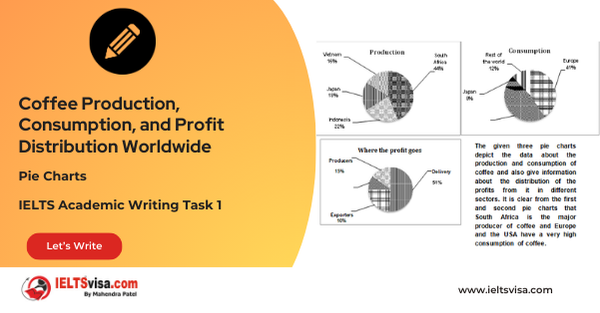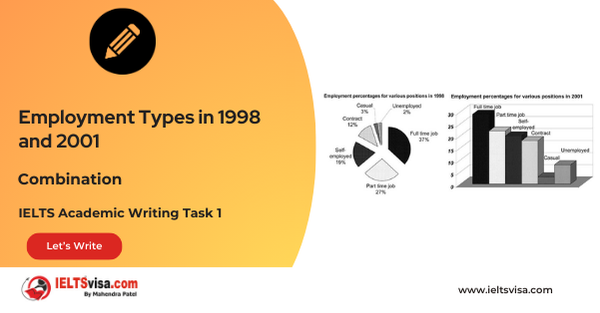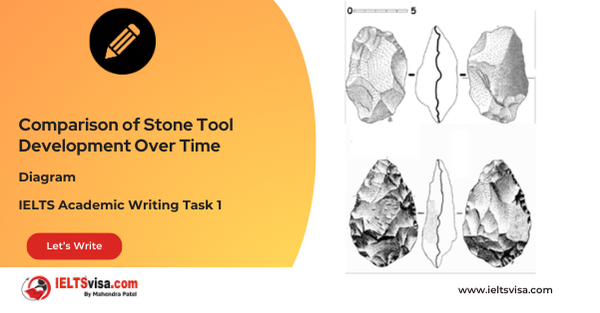Relating to people within 15-minute drive service in a particular region in UK
IELTS Academic Writing Task 1 - Bar Graph
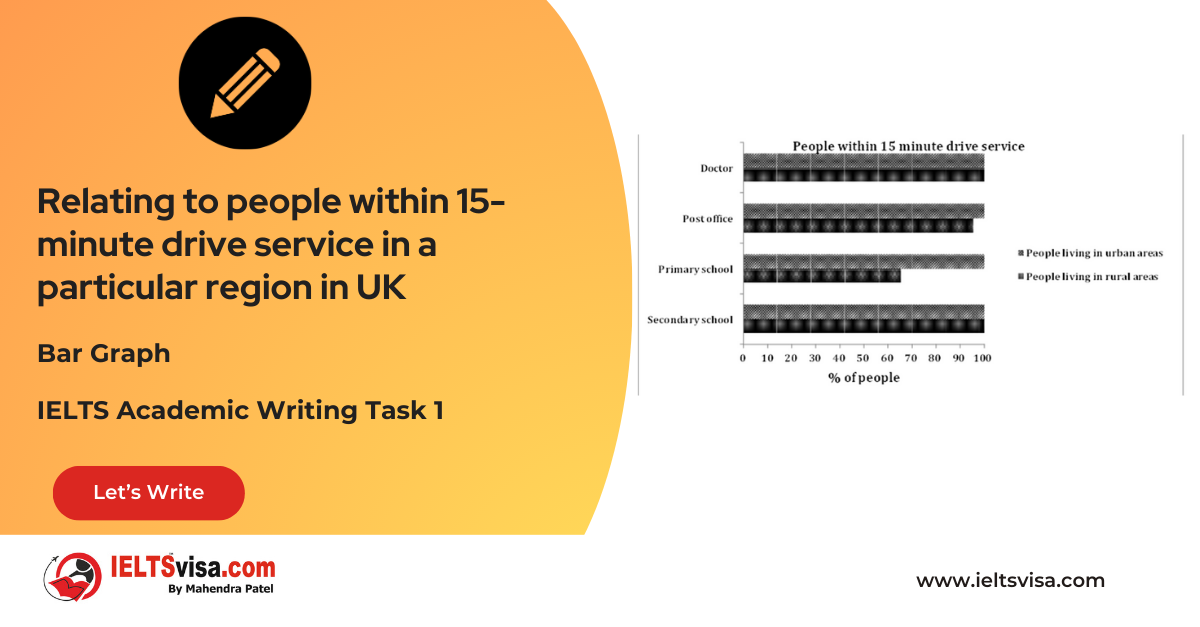
IELTS Writing Task 1 Question
The chart shows the information relating to people within 15-minute drive service in a particular region in UK. It also compares the people living in urban areas and people living in rural areas. Write a report for a university lecturer describing the information given below.
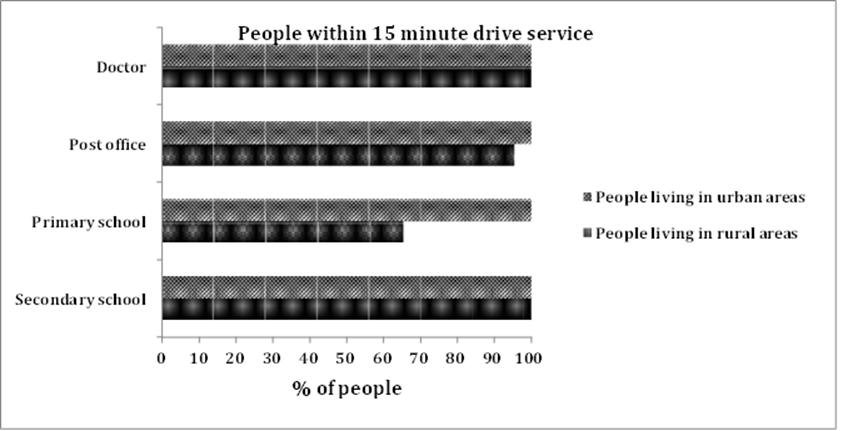
Key Points for the Report
1. Graph Type: Bar Graph
2. Title: Access to Services within a 15-Minute Drive in a UK Region
3. Units of Measurement: Percentage of people within a 15-minute drive
4. Who: People living in urban and rural areas
5. When/Where: A specific region in the United Kingdom
Topic: Comparison of access to services (medical, educational, postal)
Main Features and Trends
Current Statistics :
- Medical Services: 100% of both urban and rural populations are within a 15-minute drive to a doctor.
- Secondary Schools: Full access for all urban and rural residents.
- Postal Services: All city residents have postal services nearby. In rural areas, 95% are within the 15-minute range, with 5% having to drive farther.
- Primary Schools: The most significant difference—65% of rural residents have a primary school within a 15-minute drive, while approximately 35% do not.
Sample Answer
The bar graph provides a comparison of access to medical, educational, and postal services for people in urban and rural areas within a 15-minute drive in a region of the UK.
Overall, nearly all urban residents have close access to these services, while rural residents show slight variations, especially in primary school access.
All urban and rural inhabitants are within a 15-minute drive of medical facilities. Similarly, secondary schools are reachable within this time frame by both city and village populations. Post offices are accessible within 15 minutes for all urban residents, while 95% of rural residents have the same access, leaving 5% needing to travel further.
The primary school access shows the most enormous difference between urban and rural areas. While city residents have consistent access within a 15-minute drive, only 65% of rural residents can reach a primary school in that time, meaning approximately one-third must drive longer distances for education.
You can write “Overall” another way.
“Overall, while urban and rural residents have nearly equal access to medical, secondary school, and postal services, a significant proportion of rural dwellers do not have a primary school within close reach.”
Top 25 Vocabularies
| Vocabulary (type) | Type | Meaning | Synonyms | Examples |
|
Access (n./v.) |
Noun/Verb |
The means or ability to approach or use |
Reach, entry, availability |
“All urban residents have access to postal services.” |
|
Propinquity (n.) |
Noun |
Nearness in place or time |
Proximity, closeness, adjacency |
“City residents have post offices in their propinquity.” |
|
Discrepancy (n.) |
Noun |
A difference or inconsistency |
Difference, variation, divergence |
“The biggest discrepancy is in access to primary schools.” |
|
Avail (v.) |
Verb |
To make use of something |
Use, benefit, utilize |
“Villagers have to drive more than fifteen minutes to avail postal services.” |
|
Inhabitants (n.) |
Noun |
Residents or people living in an area |
Dwellers, residents, population |
“One-third of countryside inhabitants have to drive to far-off schools.” |
|
Comparison |
Noun |
The act of evaluating similarities and differences |
Contrast, assessment, juxtaposition |
“The bar graph provides a comparison of service access.” |
|
Urban |
Adjective |
Related to cities or towns |
City, metropolitan, town |
“Urban residents have better access to services.” |
|
Rural |
Adjective |
Related to the countryside or areas outside cities |
Countryside, provincial, agricultural |
“Rural areas face challenges in access to services.” |
|
Variation |
Noun |
A change or difference in condition or level |
Difference, deviation, alteration |
“There is a slight variation in access to primary schools.” |
|
Proportion |
Noun |
A part, share, or number considered in relation to a whole |
Fraction, percentage, ratio |
“95% of rural residents have access to post offices.” |
|
Service |
Noun |
A system or resource provided for public use |
Facility, provision, amenity |
“Medical and educational services are available in both urban and rural areas.” |
|
Facility |
Noun |
A place or service provided for a specific purpose |
Service, establishment, institution |
“Medical facilities are available to both urban and rural residents.” |
|
Reachable |
Adjective |
Able to be accessed or arrived at |
Accessible, attainable, within reach |
“Primary schools are not as reachable in rural areas.” |
|
Consistent |
Adjective |
Regular, stable, or predictable over time |
Steady, uniform, constant |
“City residents have consistent access to primary schools.” |
|
Significant |
Adjective |
Important or meaningful in degree or quantity |
Notable, considerable, substantial |
“The most significant difference is seen in primary school access.” |
|
Distance |
Noun |
The amount of space between two locations |
Length, gap, span |
“Some rural residents must travel a longer distance to reach schools.” |
|
Proximity |
Noun |
The state of being near or close to something |
Closeness, nearness, adjacency |
“Urban residents benefit from the proximity to services.” |
|
Variation |
Noun |
A difference in amount, degree, or type |
Difference, deviation, shift |
“Access to postal services shows a slight variation.” |
|
Availability |
Noun |
The quality of being accessible or ready for use |
Accessibility, presence, attainability |
“Both urban and rural residents have availability of medical facilities.” |
|
Consistently |
Adverb |
In a steady or regular manner |
Regularly, uniformly, reliably |
“City residents can consistently access services within 15 minutes.” |
|
Proportionate |
Adjective |
Corresponding in size, degree, or number to something else |
Corresponding, equivalent, commensurate |
“The proportion of rural residents with access to primary schools is lower.” |
|
Dwellers |
Noun |
Inhabitants or people living in a particular place |
Residents, inhabitants, population |
“Rural dwellers may have to travel farther for services.” |
|
Proximity |
Noun |
Nearness in place or time |
Closeness, nearness, adjacency |
“City dwellers enjoy proximity to essential services.” |
|
Slight |
Adjective |
Small or minor in degree |
Minimal, small, insignificant |
“There is a slight variation in access to services in rural areas.” |
|
Divergence |
Noun |
A difference or separation between two things |
Discrepancy, variation, deviation |
“There is a divergence in access to primary schools in urban and rural areas.” |

Our Books
Master IELTS Speaking Part 1
IELTS Writing Task 1 Book
IELTS Writing Task 2 Book
Writing Task 1 Question Types
Practice IELTS Other Modules
IELTS Listening
The IELTS Listening test assesses how well you can understand spoken English in various contexts. It lasts about 30 minutes and is divided into four sections with a total of 40 questions. The listening tasks become increasingly difficult as the test progresses.
IELTS Academic Reading
The IELTS Academic Reading section assesses your ability to understand and interpret a variety of texts in academic settings. It is designed to evaluate a range of reading skills, including skimming for gist, reading for main ideas, reading for detail, understanding inferences, and recognizing a writer's opinions and arguments.
IELTS Speaking
The IELTS Speaking test assesses your ability to communicate in English on everyday topics. It lasts 11-14 minutes and consists of three parts: introduction, cue card, and a discussion based on the cue card topic.
IELTS General Reading
IELTS General Reading tests your ability to understand and interpret various types of texts. Here are some key areas and types of content you can expect to encounter in the reading section, along with tips for effective preparation.
IELTS Academic Writing Task 1
In IELTS Academic Writing Task 1, you are presented with a visual representation of information, such as graphs, charts, tables, or diagrams, and you are required to summarize, compare, or explain the data in your own words.
IELTS General Writing Task 1
In IELTS General Writing Task 1, you are required to write a letter based on a given situation. The letter can be formal, semi-formal, or informal, depending on the prompt. Here’s a breakdown of the key components to include in your letter
IELTS Academic Writing Task 2
In IELTS Academic Writing Task 2, you are required to write an essay in response to a question or topic. Here’s a guide to help you understand the essential elements of this task
IELTS Exam Tips
To succeed in the IELTS exam, practice regularly, familiarize yourself with the test format, improve your vocabulary, develop time management skills, and take mock tests to build confidence.
Grammer for IELTS
Grammar is the foundation of effective communication in English. Understanding tense usage, subject-verb agreement, and sentence structure enhances clarity and coherence in writing and speaking.
Vocabulary for IELTS
Vocabulary plays a crucial role in the IELTS (International English Language Testing System) exam, especially in the Speaking and Writing sections. Here’s an overview of why vocabulary is important and how it impacts your performance
RECENT IELTS SAMPLES QUESTIONS AND ANSWERS
Task 1 – Column graph – Percentage of Young People Enrolled in Universities in 2000 and 2007.
20:00 Start Pause Stop [df_adh_heading title_infix="IELTS Writing Task 1 Question" use_divider="on"...
Task 1 – Bar Graph – Annual Teaching Hours by Teachers in Different Countries (2001)
20:00 Start Pause Stop [df_adh_heading title_infix="IELTS Writing Task 1 Question" use_divider="on"...
Task 1 – Pie Charts – Coffee Production, Consumption, and Profit Distribution Worldwide
20:00 Start Pause Stop [df_adh_heading title_infix="IELTS Writing Task 1 Question" use_divider="on"...
Task 1 – Column graph – Types of Transport Used by Tourists Visiting New Zealand from Five Countries in 2004.
20:00 Start Pause Stop [df_adh_heading title_infix="IELTS Writing Task 1 Question" use_divider="on"...
Task 1 – Bar and Pie Chart Combination – Employment Types in 1998 and 2001
20:00 Start Pause Stop [df_adh_heading title_infix="IELTS Writing Task 1 Question" use_divider="on"...
Task 1 – Diagram – Comparison of Stone Tool Development Over Time
20:00 Start Pause Stop [df_adh_heading title_infix="IELTS Writing Task 1 Question" use_divider="on"...


